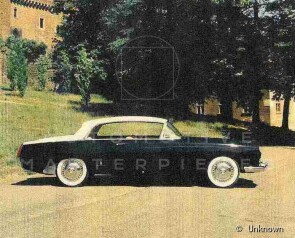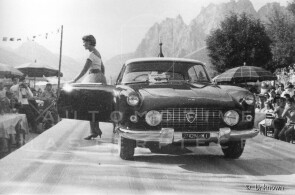
1955 Lancia Florida
ON/OFF
Why am I an Automotive Masterpiece?
L. Limited edition cars
no. 5 manufactured, 1st built. Of 5 Lancia Florida built, this is the only 2-door coupé
The Aurelia is a car produced by Lancia from 1950 to 1958, available in sedan, coupé, and convertible versions. More specifically, bare chassis for the construction of "custom-built" models by various coachbuilders were produced from 1950 to 1956. In 1954, with the introduction of the "second series" of the Aurelia sedan featuring a 2.3-liter engine, the production of chassis (B52, B53) intended for coachbuilders was concluded. However, in the subsequent two years (1955–1956), Lancia's production records indicate that 14 chassis equipped with the 2266 cc engine were still built. This very limited production is distinguished by the designations B55 and B56, which, like the earlier B52 and B53, denote different chassis, distinguished solely by the final gear ratio adopted. Essentially, these B55 and B56 chassis (B55S and B56S for left-hand drive) were employed either for Lancia’s internal use or as the foundation for some unique creations by Pinin Farina. These include a B55 chassis (with a shortened wheelbase) used to produce the final coupé of the PF200 series, a B56 chassis configured as a limousine bodywork, and 4 or 5 B56 chassis used for the "Florida" series bodies. Notably, one chassis from this series was sold to Ghia, who built a coupé on it. Finally, a mystery surrounds the "Florida 2" model unveiled in autumn 1957, which may have been developed using one of these rare chassis.
The Lancia Florida prototype, chassis no. B56-1002, made its debut in April 1955 at the Turin Motor Show, showcased at the Pinin Farina stand. The car was built on the Aurelia B56 chassis, which was dedicated to coachbuilder realizations, and it featured the 2.3-liter engine from the Aurelia B12. The model, with a two-door coupé body, remained a unique piece, but its success led to a very small series of 3-4 four-door examples, which eventually evolved into the mass-produced Lancia Flaminia, launched in 1956. The pillarless design of the Florida was characterized by straight lines and sharp edges, as well as many striking design elements, such as flat body panels with a single crease running just above the wheel arches, headlights seamlessly integrated into the grille, a recessed rear windshield, and flying buttresses. The significance of this car goes beyond its breathtaking lines. It represents a turning point in automotive design history and would influence the automotive design world for the following decade, inaugurating a new generation of cars: the previous monolithic design trend, characterized by rounded, compact shapes as if carved from a solid block, was replaced by an architecture composed of interlocking panels. “They called it my challenge in proportions to the American system,” wrote Battista (Pinin) Farina a few years later in his famous memoir. “Indeed, the roof was designed to extend its characteristic line to the entire vehicle; the bumper was integrated into the bodywork. The first two-door version was two-tone, not to achieve different color effects but to establish a balance between two compositional masses. I used edges joined by small radii of curvature,” Pinin continued, “while the front grille accentuated the sweeping line of the hood. The most expressive element of the body was the roof, which connected with the reliefs of the rear fenders: blind spots were almost completely avoided.” His son Sergio added a few years later: “The stylistic concept was immediately reworked into a study that approached mass production... the four-door Florida... from which the Flaminia would derive.” Passionate about sports cars, tenor Antonio Melandri, born in Faenza and adopted by Milan, visited the Turin Motor Show to admire up close what he had decided would be his next car, the Aurelia B20. But as soon as he came across the Pinin Farina stand, he was literally captivated by the lines of the Florida. The Milanese artist immediately got in touch with the officials of the Turin coachbuilder to begin negotiations, but Pinin Farina had not planned to sell the car, designed as a new manifesto of style, and entered in the elegance competitions of Lucerne and Geneva. Melandri did not give up and insisted, offering something like a blank check. On May 15, 1955, his persistence paid off, despite the final price being almost double that of the B20: the chassis cost 1,589,000 lire, to which the bodywork cost, 1,800,000 lire, had to be added. The Lancia Florida prototype, chassis no. B56-1002, won numerous accolades. On May 20, Pinin Farina paraded the Florida at Lucerne, where it was awarded the Grand Challenge Cup. At the end of the month, Melandri was able to collect the car, registered with the plate MI 274296, from the Pinin Farina workshops on Corso Trapani in Turin. On June 5, to honor commitments made, the prototype paraded in Geneva, winning the most coveted prize: the Golden Rose. Other appearances followed in September: in Cortina d'Ampezzo, Campione d'Italia, and Rome, all with significant recognition. Over the years, the owner, who regularly used the Florida, made some functional updates, such as simplifying the rear window mechanism, which did not work perfectly. Electric windows (Ducellier) were added, and in the early 1960s, it was decided to repaint the bodywork in classic Lancia blue instead of the original two-tone. About ten years later, after having traveled about 80,000 km, it was parked in a public underground garage in Genoa and was no longer used. The parking lot was unsupervised, and unfortunately, the car was vandalized. However, fate was kind: on December 31, 1980, the sale was formalized in favor of Lorenzo Boscarelli, a great enthusiast, co-founder, and president of AISA (Italian Association for Automotive History), and author of several volumes on the history of automobiles, who decided to preserve it in a farmhouse on the road from Fiorenzuola to Castell'Arquato, away from ill intentions. In 2011, it was purchased by another figure in international vintage motoring, Stefano Chiminelli. And finally, in 2014, the car became part of the prestigious collection of Corrado Lopresto, who deserves credit for rescuing the vehicle and subjecting it to a meticulous restoration, which turned out to be very complicated and took four years. Lopresto says of it: "In the case of the Florida, the research work for original materials that would allow an accurate reconstruction of the various missing components really took a lot of time... As soon as I got hold of various photographs and reconstructed its history... I moved on to... identifying a team of specialists who could follow my instructions to the letter... I have to thank my team, from the Airaghi body shop to the Colombo workshop, and the invaluable Mario Rigotti and Fabio Verin. Now it is perfectly functional, with the interior preserved and the mechanics fully revised, ready to be used and once again participate in elegance competitions, which in my opinion constitute the natural setting for the Florida.





